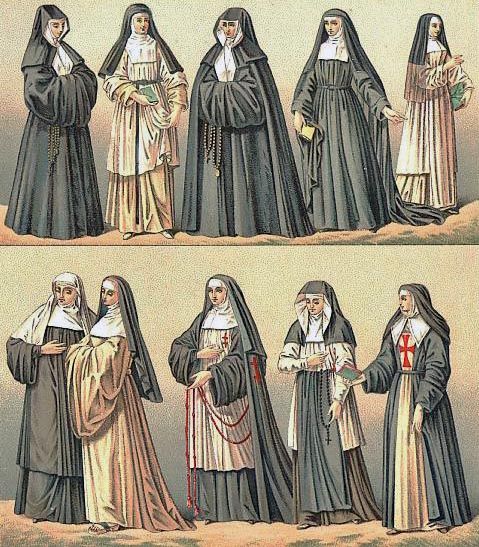Nuns wear habits. Nearly everyone knows this. But a little research uncovered so much more about the garb of nuns!
Wikipedia defines a religious habit as “a distinctive set of garments worn by members of a religious order.” The type of garment varies widely across religious orders around the world, so we’ll focus here on the habit of Roman Catholic nuns. I’ll describe a traditional habit, though contemporary nuns may dress in simple business suits.

A nun’s attire has many elements! Technically, only one piece (the tunic) is the habit itself. Here’s a description of the complete ensemble:
- White coif: The garment’s headpiece. Includes the white cotton cap secured by a bandeau and a white wimple of starched cloth to cover the cheeks and neck. Some Catholic orders use a cornette as part of the coif, a stiff headpiece sitting on top of the white cotton cap. (Think “The Flying Nun” of 1960s TV.)
- Veil: Worn pinned over the coif. Can be worn down to cover the face or up to expose it. Veils could be black, gray, or white, and sometimes are used to differentiate nuns from novitiates.
- Holy habit: The central piece of the garment, also referred to as a tunic. A loose dress made of fabric pleated at the neck and draping to the ground. Can be worn pinned up in the front or back to allow the nun to work.
- Woolen belt: A belt of woven wool secured around the waist over the tunic. In some orders, the scapular is worn over the belt, in others it is worn under the belt.
- Rosary: The nun’s rosary of wooden beads and metal links hangs from the belt by small hooks.
- Sleeves: The habit contains two sets of sleeves, the larger of which can be worn folded up for work or folded down for ceremonial occasions or whenever entering a chapel.
- Cross: A cross of silver traditionally hangs from a black cord around the nun’s neck.
- Ring: Nuns who have taken final or “perpetual” vows indicate this status by wearing a simple silver ring on the left hand. (Some sources say the ring is worn on the right hand.)
- Underskirts: The complete vestment includes two underskirts, a top skirt of black serge trimmed with cord and a bottom skirt of black cotton.
- Scapular: A symbolic apron that hangs from both front and back, worn over the tunic or holy habit.
- Card: This stiff black covering is worn over the coif when the nun leaves the convent to prevent the coif from becoming wet or soiled.
- Shoes: Simple functional black shoes are the usual footwear.
- Suitcase: Nuns often travel with a small black hand-held bag containing personal items and toiletries.
- Apron: A variety of styles of aprons can be worn over the habit to protect it during work activities
As mentioned above, contemporary nuns and monks may wear a simple business suit instead of a habit. All that is required by Catholic Canon Law is that the attire be identifiable in some way so that the person may “serve as a witness to Gospel values.” This is a useful loophole for religious personnel in Turkey, where religious garb is not allowed in public.
A “nun in training”, such as an Aspirant, Postulant, or Novitiate, wears something other than the full habit of a nun. Aspirants and Postulants wear street clothes. Novitiates are clothed in a habit as part of the ceremony that marks the end of their postulancy, but their habit is usually different in some way from a nun’s garb, often distinguished by a different color veil. As mentioned in an earlier post, only nuns who have taken their second set of vowels wear a ring, signifying they are a bride of Christ.
While the trend has been to wear more contemporary attire than the traditional habit, NPR ran a feature five years ago on the Dominican Sisters of St. Cecilia, a convent in Nashville, Tennessee. This group of nuns bucks a couple of trends: First, the average age of a nun in the US is in the mid-70s; at the Nashville convent, the average age is 36! Second, the nuns at St. Cecilia’s wear the full traditional habit rather than contemporary garb. In their case, habits are the new radical!
 See our nuns in the world premiere of Death is a Bad Habit! Opening New Year’s Eve at the Eisemann Center in Richardson. To purchase tickets, call 972-744-4650 or visit www.eisemanncenter.com
See our nuns in the world premiere of Death is a Bad Habit! Opening New Year’s Eve at the Eisemann Center in Richardson. To purchase tickets, call 972-744-4650 or visit www.eisemanncenter.com
